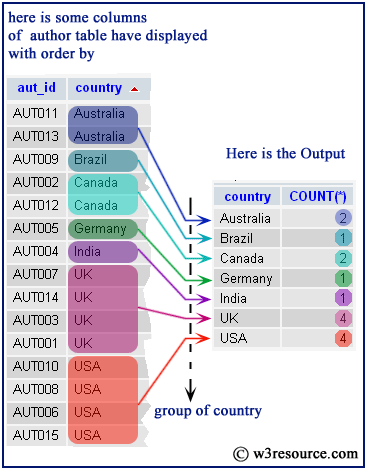The GROUP BY statement groups rows that have the same values into summary rows, like find the number of customers in each country. In this post we’ll write many example about group by clause on library database. Some of this examples will be easy, and the others ones will be expert. With this examples you can learn how the group by clause used. The basic syntax of a GROUP BY clause is shown in the following code block.
Only include countries with more than customers. SQL GROUP BY Examples ProbleList the number of customers in each country. SELECT COUNT(Id), Country FROM. SUM is used with a GROUP BY clause. The aggregate functions summarize the table data.
Once the rows are divided into groups , the aggregate functions are applied in order to return just one value per group. It is better to identify each summary row by including the GROUP BY clause in the query resulst. SQL HOME SQL Intro SQL Syntax SQL Select SQL Select Distinct SQL Where SQL An Or, Not SQL Order By SQL Insert Into SQL Null Values SQL Update SQL Delete SQL Select Top SQL Min and Max SQL Count, Avg, Sum SQL Like SQL Wildcards SQL In SQL Between SQL Aliases SQL Joins SQL Inner Join SQL Left Join SQL Right Join SQL Full Join SQL Self Join SQL Union SQL Group By SQL Having SQL Exists SQL Any.

Keep your team up-to-date with the latest techniques in data science. The GROUP BY clause in SQL is used to arrange the same data into groups with the help of some functions. In practice, the GROUP BY clause is often used with aggregate functions for generating summary reports. SQL Server GROUP BY clause and aggregate functions. An aggregate function performs a calculation on a group and returns a unique value per group.
Sql Group By Quarter Examples. We use datepart method to get quarter part of a date. We will do some examples on library database. This video talks about Group by in sql sql group by examples sql group data sql group by sum of data group by examples in sql sql group by having clause.
Dieser SQL -Befehl wird häufig in Kombination mit den. The GROUP BY concept is one of the most complicated concepts for people new to the SQL language and the easiest way to understand it, is by example. SQL gives you options for retrieving, analyzing, and displaying the information you need with the GROUP BY, HAVING, and ORDER BY clauses. SUM() function with group by.
Here are some examples of how you can use them. GROUP BY clauses Sometimes, rather than retrieving individual records, you want to know something about a group of records. Standard SQL does not allow you to use an alias in the GROUP BY clause, however, MySQL supports this.
For example , the following query extracts the year from the order date. It first uses year as an alias of the expression YEAR(orderDate) and then uses the year alias in the GROUP BY clause. Keine Setup- und Abo-Kosten. In this blog, we will discuss how to work with GROUP BY, WHERE and HAVING clause in SQL and explain the concept with an example in a simple way. I hope this is very useful for beginners and intermediate to help them understand the basic concept.
GROUPING SETS tutorial for the demonstration. If you have not created the sales. MySQL GROUP_CONCAT function : common mistakes.
The GROUP _CONCAT() function returns a single string, not a list of values. It means you cannot use the result of the GROUP _CONCAT() function for IN operator e. I know that in sql server we cannot use Group _concat function but here is one issue i have in which i need to Group _Concat my query. How can I using group by with union in t- sql ? Find Group By Sql Example and Informative Content.
Group functions are built-in SQL functions that operate on groups of rows and return one value for the entire group. But what if you want to aggregate only part of a table? SQL aggregate function like COUNT, AVG, and SUM have something in common: they all aggregate across the entire table. First, examines the GROUP BY clause and divides the products into groups based on the product category categoryid.
Secon calculates the total of units in stock by using the SUM function for each group. SQL for Beginners (Part 7) : The GROUP BY Clause and HAVING Clause This is the seventh part of a series of articles showing the basics of SQL. In this article we take a look at the GROUP BY clause and HAVING clause in SQL. It is typically used in conjunction with aggregate functions such as SUM or Count to summarize values. In SQL groups are unique combinations of fields.
SQL ROLLUP with one column example. Reporting Aggregate data using the Group functions. SQL has numerous predefined aggregate functions that can be used to write queries to produce exactly this kind of information.
The other examples do not specify this predicate.
Keine Kommentare:
Kommentar veröffentlichen
Hinweis: Nur ein Mitglied dieses Blogs kann Kommentare posten.